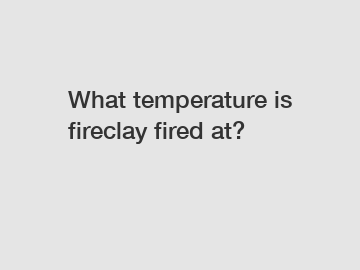What temperature is fireclay fired at?
Fireclay is a remarkable material that has been used for centuries in the manufacturing of various products such as bricks, tiles, and ceramics. Its versatility and durability make it a popular choice for a wide range of applications. However, one question that often arises is what temperature fireclay is fired at.
To understand the firing process of fireclay, we must first look at its composition. Fireclay is a type of clay that is highly heat resistant, making it ideal for use in high-temperature environments such as kilns and furnaces. When fireclay is heated to a certain temperature, it undergoes a transformation that makes it stronger and more durable.
The temperature at which fireclay is fired depends on the specific requirements of the product being manufactured. In general, fireclay is fired at temperatures ranging from 1,700 to 2,200 degrees Fahrenheit. This high temperature is necessary to ensure that the clay reaches its maximum strength and durability.

At these high temperatures, the molecules in the clay begin to break down and recombine in a process known as vitrification. This results in a hard, dense material that is highly resistant to heat, chemicals, and wear. The firing process also removes any impurities in the clay, ensuring a high-quality finished product.
The firing of fireclay is a complex and precise process that requires expert knowledge and specialized equipment. Kilns used for firing fireclay must be able to reach and maintain the high temperatures required for vitrification. The firing schedule must be carefully monitored to ensure that the clay is heated evenly and at the correct rate.
In addition to temperature, other factors such as time and atmosphere also play a role in the firing process. Different types of fireclay may require different firing schedules to achieve the desired results. Some products may require multiple firings at different temperatures to achieve the desired strength and appearance.
One of the key benefits of firing fireclay at high temperatures is that it creates a product that is not only durable but also resistant to heat and chemicals. This makes fireclay ideal for use in applications where strength and longevity are important, such as in the construction of kilns, furnaces, and industrial equipment.
In addition to its practical applications, fireclay is also prized for its aesthetic qualities. The firing process can create unique colors and textures in the clay, making it a popular choice for decorative tiles, pottery, and other artistic creations. The high temperatures at which fireclay is fired can create striking patterns and effects that add a touch of beauty to any project.
Overall, the temperature at which fireclay is fired plays a crucial role in determining the quality and properties of the finished product. Whether used in industrial applications or artistic endeavors, fireclay's ability to withstand high temperatures makes it a versatile and valuable material.
In conclusion, the firing of fireclay at high temperatures is a precise and complex process that requires expert knowledge and specialized equipment. By understanding the role that temperature plays in the firing process, manufacturers can create products that are not only durable and strong but also beautiful and unique. Whether used in industrial settings or for artistic purposes, fireclay remains a timeless material that continues to inspire and impress with its strength and versatility.
If you are looking for more details, kindly visit refractory mortar, ceramic fibre blanket dealer, Fireclay Brick Recipe.

Comments
0